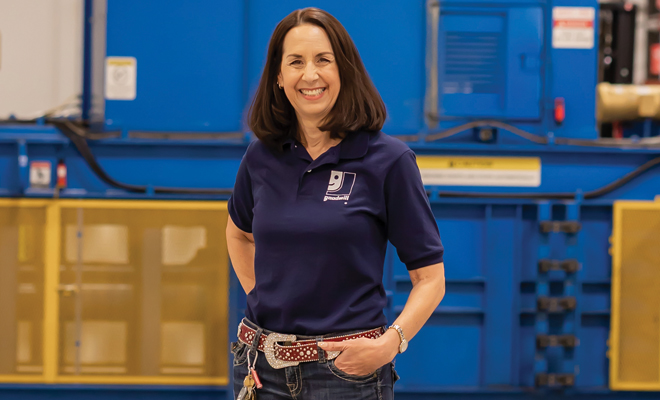 Ann Ishii
Ann Ishii
Denise Ost: “Goodwill is so much more than a thrift store!”
How often do we consider the second lives of the items we donate? For many of us, they leave our minds once we drop them off at our local Goodwill. But everything that’s donated to Goodwill gets a chance to extend its usefulness. The old coat your daughter outgrew can keep a child warm this winter. The serving platter you just don’t like can find a new place in someone’s first home. The blazer you don’t wear anymore can be worn to someone’s job interview.
But these donated items also have a significant impact on the many people who work at Goodwill. Just like we may forget to consider what happens to our donated goods, many may not think about the hard work that goes into every aspect of the day-to-day business at Goodwill, a carefully connected web of people who process donations, put items on the floor, ring up your purchases, haul merchandise, or take care of the things that don’t sell. For some of these employees, it’s simply a job; for others, it’s so much more. Someone who knows this better than anyone is Denise Ost.
Career Path
What began as a human resources job at Goodwill right out of college in August 1984 eventually turned into something much bigger for Denise. It’s safe to say that the Lodi native never imagined that she’d work her way up and that in 2022, she’d not only be leading Goodwill Industries of San Joaquin Valley Inc. as president and CEO, but she’d also be overseeing the biggest move in their 80-year history. “I’ve done pretty much every job at the agency besides driving a Class A truck,” she said, reflecting on her history with Goodwill. “I feel like I’m a living example of Goodwill’s mission of the power of work to change lives.”
Goodwill has been practicing what they preach for quite some time. It was founded in 1902 by the Rev. Edgar J. Helms, who collected used clothes and household goods and then hired and trained people to mend and repair the goods before reselling them. Today, Goodwill’s business model is a little different, but the general philosophy remains the same: strengthening the community by reusing goods and creating jobs. While many people are most familiar with Goodwill as the popular chain of thrift stores where you can donate and find preloved and gently used items, there’s more here than meets the eye. Everything you see at a Goodwill store started as a donation, but the steps that are taken to get the items from intake to the sales floor require processing and preparation, and behind those steps are numerous people keeping things running behind the scenes. “When you give to Goodwill, you’re creating a job,” said Denise. “And that job is changing someone’s life.”
Depth of Opportunity
Whether a job at Goodwill is a stepping stone on someone’s journey or it becomes a career as in Denise’s case, it’s clear that they’re dedicated to investing in their employees. Goodwill offers classes and job training services for their employees, meaning prospective applicants can get hired with practically no skills and learn as they go while earning a paycheck. Some people have even started as donation attendants and ended up being Class A truck drivers. And many of the skills employees can learn at Goodwill, such as computer and digital skills, can be applied to jobs at other companies if they decide to move on. “The best part about working at Goodwill is the opportunity to constantly learn and grow, and that’s been the case from the day I started until today,” shared Denise.
Even Goodwill’s website offers job and career advice for the general public, always circling back to their mission of helping individuals and families reach their full potential through employment. Goodwill also prides themselves on employing people with disabilities and disadvantaged conditions, and for being a place where people can get their first start or a second chance. And they teach more than just job skills; Goodwill employees can take classes on subjects such as communication, critical thinking and problem solving, budgeting and more. “We can connect staff with legal counsel, with healthy eating programs, with personal counseling for themselves and family members,” added Denise. “It takes a lot of support around an individual, including in their household, for people to be able to show up to work effectively.”
For the Future
Over the course of her career at Goodwill, Denise has loved witnessing success stories unfold in real time. And now she gets to see another big event, one that will go on to affect numerous lives for decades into the future. Denise is currently preparing their organization for a move from their downtown Stockton location on Grant Street to a 90,000 square foot state-of-the-art facility on Arch Road. They’ll be opening their first 10,000 square foot outlet store, which will create new jobs for the community, allow for more customers and generate millions more for Goodwill’s mission services.
Their new facility will also expand logistics to include 16 dock bays, an improvement over the four dock bays they’ve previously been working with. This monumental move, which started in 2019 but is finally nearing completion, will expand job training services, double the number of jobs for the community, support twice the number of retail thrift stores and allow for the recycling of more pounds of product every year. With 15 store locations and 17 donation sites in the San Joaquin Valley, it’s easy to imagine how much gets donated each year. And Goodwill’s little-known recycling program is another reason they’re a popular pillar of sustainability.
Repurpose and Reuse
“We’re the original recyclers, long before recycling was chic,” quipped Denise. “At Goodwill we give people and things a second chance.” Recycling at Goodwill is a fairly large undertaking, but it’s a very worthwhile one. In addition to being a state-certified collector of electronic waste, Goodwill recycles plastics, bags, glass, shoes and clothes. When something doesn’t sell, it’s brought back to the distribution center for another chance to be sold by the pound through the outlet store. If it doesn’t sell there, it’s bundled up, and they sell as much of the byproduct as they can to other recyclers. All these items must be sorted and then stored until shipping time, and that requires space; when they sell to recyclers, these items must go out in large containers rather than small batches. But at their new facility, the larger square footage and extra dock bays mean more space to sort plastics out from glass to fill entire trailers that will be sold to secondary markets. “We work really hard to keep as much of the items that are donated to us out of the community landfill,” explained Denise. She estimates that every year they keep roughly nine million pounds of merchandise out of the landfill, but that will double at their new facility.
Please Follow Procedures!
At the start of the pandemic, the extra time spent at home inspired many people to do some deep cleaning of their closets and cupboards, and the result of that was a significant uptick in donations. While the donations keep people working, Denise stresses that they must be done properly. One of the many misconceptions that people have about Goodwill is that they can simply drop off their items even if there’s no one there to receive them, but that’s not true; in fact, it disrupts the efficient processes that are constantly in motion and have kept Goodwill running for so long. Donations cannot be left by the closed doors; they must be left with an attendant or not left at all.
Another common misconception is that people sometimes think that just because Goodwill receives donations, these items should be free to whoever wants them. But Goodwill is a not-for-profit agency, and the money generated through those retail purchases pays salaries, keeps the lights on at the stores, fills the gas tanks of the Goodwill trucks and goes toward all the other things it takes to operate a business. “Governmental reporting, payroll taxes, insurance, utilities, rent and all those things,” added Denise. “And, there is the cost to providing our mission services of job coaching, job training, life skills training, and all the ways we’re supporting people to get into or back into the workforce.”
Yes, Donating Is Worth It!
For anyone who wonders if they should make the effort to go to a Goodwill location to donate their items rather than just toss them in the trash, the answers are obvious. It’s better for the environment to not let things rot in a landfill; and if your items are still in good condition, they can continue to be useful for many more years with someone else. Thrifting may be wildly popular among young folks looking for unique styles these days, but there are also people who shop at Goodwill because they’re seeking reasonably priced items for their important and everyday moments. It would be an understatement to say that lives are being affected by Goodwill in countless ways, all year round. This mecca for secondhand shoppers cares about fulfilling your thrifting needs, but they also care about helping people attain and maintain self-sufficiency through the power of a good job. “I’ve had a lot of difficulties in my own life,” shared Denise. “The one constant for me has been Goodwill. I’m really proud to say I work for Goodwill and that I get to lead Goodwill is truly a gift.”
Goodwill’s enduring popularity is often credited to many things: for their sustainable retail model of reselling and recycling; for being an invaluable institution for people who need to shop for certain items on a budget; and of course, for those who love getting lost among the aisles and the clothing racks, finding hidden gems they didn’t know they needed. But it’s important to remember that the employees are an essential aspect of Goodwill, and for many of them, this job could be making the biggest difference in their lives; just like some of the items you part ways with, they may do the same for someone else.
“Goodwill is important because we see potential in all people and all things,” said Denise. “Everyone and everything have value.”







